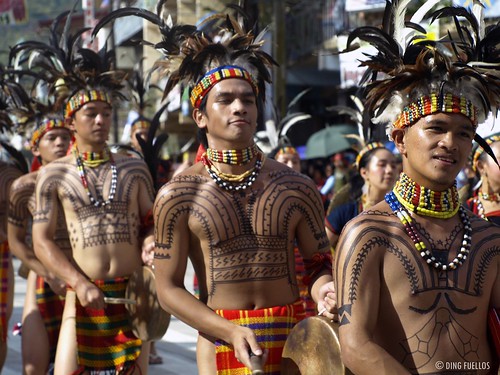
SELF-ASSURING elderly men wore their G-strings and their necklaces made either of fangs or teeth of wild boar, suggesting their bravery and robustness in the days of hunting and fighting against other tribes. With their genuine repolished spears, machete, and their bows and arrows, they strutted along the main street of Bontoc with good bearing and pride—but this time, not to wage a war against a clan or a tribe.
In the same fashion, elderly women graced the occasion in their neatly wrapped tapis. Their gait is that of a deer; with elegant, careful and confident steps that instinctively follow a choreography taught by many generations ahead of them. Their hands, hips, heads, tussles and their heirloom beads rhythmically swayed with every beat of the gangza and solibao.
The younger participants were agiler. Their stunts are refreshing, compared to their more sober adult counterparts. They ran, chanted at the top of their lungs, and wowed the crowd with their animated war and courtship dance numbers.
Nobody can deny, the children who looked cute in their native tribal costumes were the star of the show. Yes, they made mistakes and have not perfected the steps and movements, but nobody cared! It was all for fun, after all.
Describing Lang-ay Festival is a tough job for this neophyte writer. One can never express in exact words the high spirit, and authenticity of the festival. Unlike in many other festivals, where most of the performers are teenagers or children, Lang-ay Festival’s participation of all ages in the pageantry of Mountain Province’s diverse culture, history and tradition take the center stage and what sets it apart from other festivals.
With the elderly participating in this annual event, sans the haute couture costumes found in other festivals, proves to be a travel photographer’s Eden. At the onset of modernization, elderly and young Kankanaeys, like many other cultures, no longer wear their traditional costumes, except on these occasions and in their tribal rituals. To me, this is very much understandable and acceptable these days.
In 2009, I witnessed the 5th Lang-ay Festival, which was celebrated with the theme “Nurturing History and Culture.” Held every first week of April, Mountain Province will be celebrating it for the 6th year with the theme: “Lang-ay: A Tool For Reconciliation, Solidarity, and Transformation.” This week-long celebration will be observed with various events like information caravan of the province’s services, agricultural trade fair, forum, cultural plays, and performances, and culminates in a grand parade featuring every municipality of the province.
In Igorot dialect, “Lang-ay” means a fellowship where local folks gather to celebrate and perform “cañao” that involves the offering of locally brewed rice wine or tapey, and butchering pigs, chicken, harvest and prayers to their pagan gods. It also signifies the traditional practice of generosity, sharing, and respect.
In the past decades, Mountain Province has been plagued by tribal wars and conflicts among clans, until a peaceful resolution has been reached through a “budong,” which was held in a month of April [Author: Corrections and additional information are most welcome.]. Thus, to commemorate this peace pact among warring tribes, the Lang-ay Festival is a fitting new tradition they must celebrate. It does not only signify a fellowship, but also of uniting the people and diverse tribes of Mountain Province for peace and development.
Moreover, the festival has also become a tool for the elderly to teach and inculcate in the younger generation the value of culture and tradition. According to Governor Maximo Dalog in a press conference in Baguio City, “The Lang-ay festival of Mountain Province held annually in April since five years ago has prevented the waning of the Igorot culture among the youths.”
For the year 2010, The festival will be held from April 4-8 and highlights the street-dancing competition among participating municipalities on April 7.
Thank you for reading The Pinoy Explorer! All contents of this blog, or otherwise stated, are copyrighted. For syndication, the use of articles and photos, send me an e-mail. Thank you!


8 comments :
Aya ka naman minsan haha
never heard of this festival but I will sure chck it out next april. and by the way, you describe the feast well. nosebleed! hihi
Gael, I consider this as my best blog post. Masyado kasi akong attached sa event na ito and the culture...salamat!
Yes try it, then akyat ka sa Sagada or explore more of Bontoc.
napaka rich talaga ng culture ng mountain province
@chris, indeed! and they are bent to preserve it!
Sir Ding! I might attend the Lang-ay this year since I'll be in the mountains this April. Anymore things to see or tips sir aside from the parade? :)
Edmar, I am not sure if they have teh same festivities like this one. But since the Holy week is earlier this year, they might have a similar one. Last year kasi parang parade lang.
Nearby is Bontoc Museum, you can walk through the Chico River, and explore the rice terraces above. That is visible from the highway. Just ask the locals how to go to the river. I think they have a nice church too, but never got the time to explore it. Enjoy!
Great blog web page ...Thanks for your amazing details, the material are silent exciting.I will be awaiting your next publish. how to catch a bass
Post a Comment